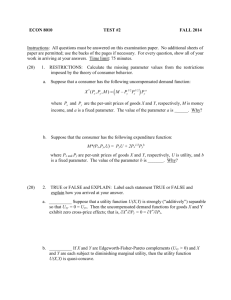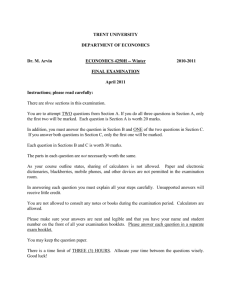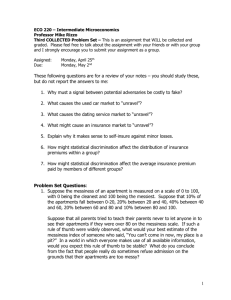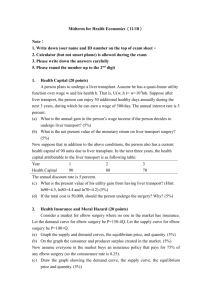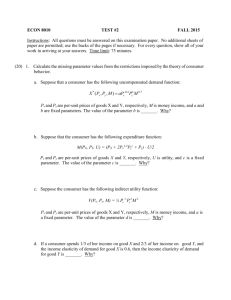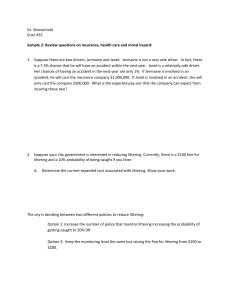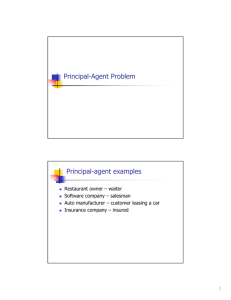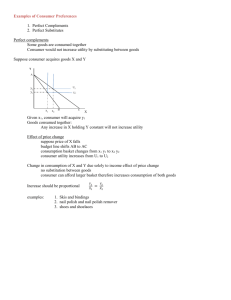Review
advertisement
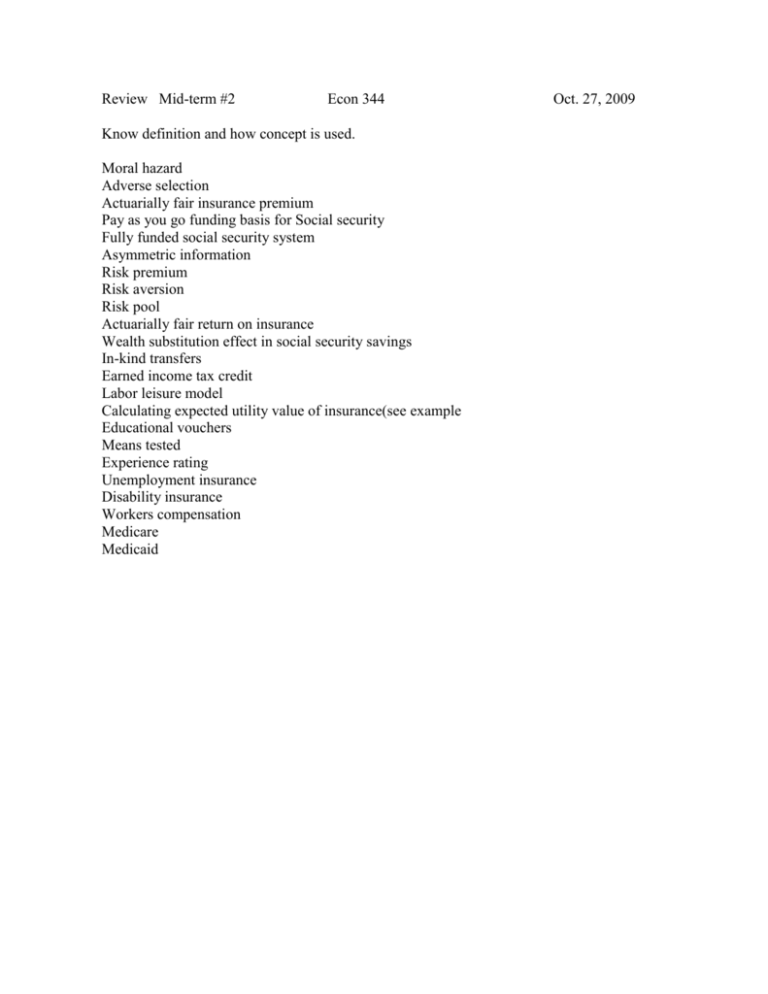
Review Mid-term #2 Econ 344 Know definition and how concept is used. Moral hazard Adverse selection Actuarially fair insurance premium Pay as you go funding basis for Social security Fully funded social security system Asymmetric information Risk premium Risk aversion Risk pool Actuarially fair return on insurance Wealth substitution effect in social security savings In-kind transfers Earned income tax credit Labor leisure model Calculating expected utility value of insurance(see example Educational vouchers Means tested Experience rating Unemployment insurance Disability insurance Workers compensation Medicare Medicaid Oct. 27, 2009 1.VinDiesel drives cars and is thinking about insurance. He has a 5% probability of an accident that will cost him $10,000. His utility ftn is U(I)=√I and his income is $40k • • • a. What is the expected income • c. What is the actuarially fair premium for insurance • d. What is utility of full insurance • e. What is utility of 50% partial insurance? b. what is his expected utility of not buying ins. • f. Should he insure? 1.VinDiesel drives cars and is thinking about insurance. He has a 5% probability of an accident that will cost him $10,000. His utility ftn is U(I)=√I and his income is $40k • a. EU=p*U(inc if hurt) + (1-p)U(inc.not hurt) (Expected utility is weighted average of utilities of incomes in different future states— weights are probabilities) .05*√(40000-10000) + .95* √(40000) =198.66 • • • • • b. .05*10000 + .95*0=$500 (actuarially fair premium is the premium that allows insurance company to breakeven) c. .05* √(40000-500) +.95(40000-500)=198.75 d..05* √(30000-250+5000) +.95* √(40000-250) =198.72 e. yes, full 2. Suppose that the demand for medical services can be characterized by the equation X = 500 – P/3. Suppose further that the supply of health services can be characterized by the equation X = P – 100. (A) What is the equilibrium quantity and price in the market for health services? (B) In an effort to make health services more affordable, the government restricts the price of health services to be no greater than $250. What will happen to the quantity of health services in the market? Ans: (A) Set 1,500 – 3X = 100 + X to get that X* = 350 and P* = $450. (B) At a price of $250, a shortage of health services will occur. X* will now be only 150. 4. Suppose the government introduces an income maintenance program for low-income people that offers a basic grant of $200 per month. For any earnings, the grant is reduced dollar for dollar (100% tax) a. Assume Lois can earn $10 per hour and has no other income. Sketch her monthly budget constraint with and without the program in effect. Carefully label axes, intercepts and all kink points. At how many hours of work is the grant reduced to 0? b. According to economic theory, what would happen to Lois’ hour worked and total income if the government instituted this program? c. Suppose the government decides to keep the grant of $200 but to lower the implicit tax rate to 50% (Lois can keep $.50 of each dollar she earns) Draw the new budget constraint. d. Which program provides more incentive for Lois to enter the work force? --the 50% tax plan (See diagram) 5. A voucher for housing is an example of an in-kind transfer. An individual with a monthly income of $800 receives a housing voucher for $200. a. Draw this person’s initial budget constraint for housing and all other goods. b. Illustrate how the housing voucher affects his budget constraint. c. Illustrate the cases where the voucher yields lower utility than a cash transfer and the case where utility is the same as a cash transfer. (see diagram below) 5b. Suppose that a family with one child has $20,000 per year to spend on private goods and education, and further suppose that all education is privately provided. Draw this family’s budget constraint. Suppose now that an option of free public education with spending of $4,000 per pupil is introduced to this family. Draw three different indifference curves corresponding to the following three situations: (a) a free public education would increase the amount of money that is spent on the child’s education; (b) a free public education would decrease the amount of money that is spent on the child’s education; and (c) a free public education would not affect the amount of money spent on the child’s education.

